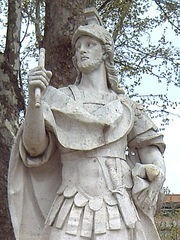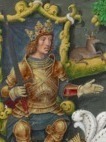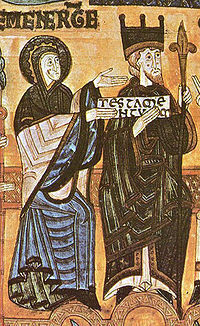Stamboom Snelder - Versteegh » King García Íñiguez I of Pamplona (810-882)
Persoonlijke gegevens King García Íñiguez I of Pamplona
- Hij is geboren in het jaar 810 in Pamplona, Navarra, Navarra, Spain.
- Hij is overleden in het jaar 882 in Battle of Aibar, hij was toen 72 jaar oud.
- Een kind van Iñigo Arista of Pamplona en Oneca Velasquez
Gezin van King García Íñiguez I of Pamplona
Hij is getrouwd met Urraca.
Zij zijn getrouwd
Kind(eren):
Notities over King García Íñiguez I of Pamplona
https://en.wikipedia.org/wiki/Garc%C3%ADa_%C3%8D%C3%B1iguez_of_Pamplona
García Íñiguez I (Latin: Garsea Enneconis, Basque: Gartzea Eneko; c. 805 – 882), also known as García I was the second King of Pamplona from 851-2 until his death. He was the son of Íñigo Arista, the first king of Pamplona. Educated in Cordoba, he was a successful military leader who led the military campaigns of the kingdom during the last years of his father's life.[1][2]
Educated in Córdoba, as a guest at the court of the Emir of Córdoba, García was the son of Íñigo Arista, the first king of a Basque dynasty ruling in Pamplona up to the late 9th century.[3] When his father was stricken by paralysis in 842, he became regent of the kingdom (or perhaps co-regent with his uncle Fortún Íñiguez). He and his kinsman Mūsā ibn Mūsā ibn Fortún of the Banu Qasi rebelled against the Cordoban emir in 843. This rebellion was put down by Emir Abd ar-Rahman II, who attacked the Kingdom of Pamplona, defeating García badly and killing Fortún. At his father's death in 851/2 (237 A.H.), he succeeded to the crown of Pamplona.
Following the death of Íñigo Arista, the Banu Qasi leader Mūsā ibn Mūsā pursued a policy of closer allegiance with Muhammad I of Córdoba, leaving García to look to Christian Asturias for an ally.[1] In 859, the Vikings captured King Garcia Iñiguez, probably far removed from the his Basque kingdom of Navarre,[4] somewhere in the Andalusian heartland, and extorted a hefty ransom,[5] rising to around 70,000 gold dinars.[6] Later the same year, Mūsā ibn Mūsā attacked the Pamplonese city of Albelda. García and his new friend Ordoño I of Asturias together dealt Mūsā a crushing blow, killing, it is said, 10,000 of his magnates in the Battle of Albelda. This, in turn, provoked a raid by Mohammed I of Córdoba[7] in response and the next year, 860, saw García's son and heir Fortún captured and imprisoned by Mohammed I of Córdoba.[7][6]
He languished in Córdoba for the next 20 years. In 870, García formed an alliance with the Muslim rebel Amrūs ibn Umar ibn Amrūs, who had killed Garcia's nephew Mūsā ibn Galindo of Huesca, and the next year was apparently in a new alliance with the sons of Mūsā ibn Mūsā, now in rebellion against Córdoba.
García's death has been subject to scholarly dispute, a result of a paucity of records from the last years of his reign. The lack of subsequent mention of him after 870 led to the suggestion that he died in that year, and as his heir was in the hands of his enemies, it was argued that García Jiménez then governed the kingdom as regent. García's son, Fortún Garcés, is then made to succeed upon his release in 880. There is, however, no evidence for such a regency, and Sanchéz Albornoz has cited evidence that García was still living at the time of his son's return.[6] Thus it is likely that Balparda was reporting an accurate tradition when he suggested García and ally Umar ibn Hafsun fought a battle at Aibar, nor far from present-day Lumbier, against the troops of the Emir of Córdoba in 882, García dying there (although the age provided him, 84 years, is clearly exaggerated).
The identity of García's wife or wives is poorly documented, and has been subject to much speculation. An undated confirmation of an earlier lost charter refers to King García and Queen Urraca Mayor, and this is thought by some to refer to García Íñiguez and an otherwise unknown wife, Urraca. Based on her name alone and the fact that one of his son's name was Fortún, a common name among the Banu Qasi dynasty, it has been argued that Urraca could have been a granddaughter of Musa ibn Musa ibn Qasi, the leader of the Banu Qasi clan.[8] Other historians have suggested alternative parentage, or suggested the document does not refer to García Íñiguez at all but instead to García Sánchez II of Pamplona and his mother Queen Urraca Fernández. A second possible wife is infanta Leodegundia, daughter of Ordoño I of Asturias. She is known to have married a ruler of Pamplona not named in the primary source, and García Íñiguez is one of those speculated to have been this prince.[1]
- Fortún Garcés, King of Pamplona from 870 until 905 and married to Auria.
- Onneca Garcés, married to Aznar Galíndez II, Count of Aragon.[9]
- Sancho Garcés, father of Aznar Sánchez de Larraun — the second husband of his cousin Onneca Fortúnez — and probably of Velazquita, who married to Mutarrif ibn Musa, of the Banu Qasi.[a]
He may also have been the father of Jimena, who married King Alfonso III of Asturias[13] between 26 May and 20 December 873, both appearing together for first time in 874 making a donation to the Cathedral of Santiago de Compostela.[14] Her name and the status of her husband as the premier monarch in Christian Iberia suggests that she could have come from nothing short of the highest levels of Pamplona society, though some have instead derived her from the ;Jimenez dynasty.
Tijdbalk King García Íñiguez I of Pamplona
 grootouders
grootouders
 ouders
ouders
 broers/zussen
broers/zussen
 kinderen
kinderen
De getoonde gegevens hebben geen bronnen.
Over de familienaam Of Pamplona
- Bekijk de informatie die Genealogie Online heeft over de familienaam Of Pamplona.
- Bekijk de informatie die Open Archieven heeft over Of Pamplona.
- Bekijk in het Wie (onder)zoekt wie? register wie de familienaam Of Pamplona (onder)zoekt.
Roel Snelder, "Stamboom Snelder - Versteegh", database, Genealogie Online (https://www.genealogieonline.nl/stamboom-snelder-versteegh/I507004.php : benaderd 26 april 2024), "King García Íñiguez I of Pamplona (810-882)".


